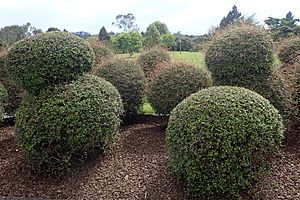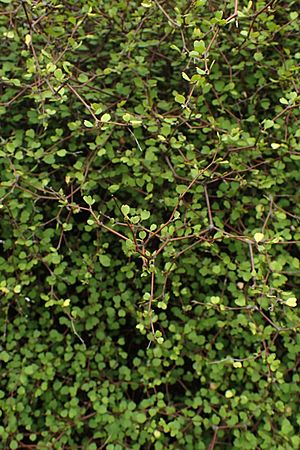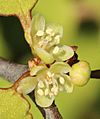Muehlenbeckia astonii facts for kids
Quick facts for kids Muehlenbeckia astonii |
|
|---|---|
 |
|
| Shrubby tororaro at Hackfalls Arboretum, Tiniroto, New Zealand | |
| Conservation status | |
 Nationally Endangered (NZ TCS) |
|
| Scientific classification | |
| Genus: |
Muehlenbeckia
|
| Species: |
astonii
|
Muehlenbeckia astonii is a special New Zealand shrub that grows nowhere else in the world. It's part of the Polygonaceae plant family. This plant has unique small, heart-shaped leaves that fall off in winter. Its branches are thin and tangled, like a messy ball of wire. Even though many people grow it in gardens around the world, it's very rare and in danger in the wild.
Contents
What's in a Name?
A scientist named Donald Petrie first described Muehlenbeckia astonii in 1911. He named it after Bernard Aston. Bernard Aston was the person who found the first samples of this plant in 1908. He found them near Palliser Bay in New Zealand.
The plant is also called shrubby tororaro. This helps tell it apart from another similar plant called tororaro (Muehlenbeckia complexa). That plant is a scrambler and doesn't have a main trunk. People sometimes call M. astonii by other fun names too, like wiggy-wig bush, zig zag plant, or wirebrush.
Where Does Shrubby Tororaro Live?
This plant probably used to grow all over the drier, lower parts of eastern New Zealand. It liked places near rivers and the coast. It might have grown as far south as the Waitaki Valley. It's hard to know its full past range. This is because scientists only learned about it after much of New Zealand's dry land was cleared for farms.
M. astonii has deep roots. This helps it live in dry places. It can grow on sunny, rocky hillsides and stony ground. It likes soil that drains well and is warm. Today, you can only find M. astonii in four main areas:
- Around Palliser Bay at the bottom of the North Island.
- In northeastern Marlborough.
- Some spots in North Canterbury.
- Kaitorete Spit near Lake Ellesmere. About 90% of all wild M. astonii plants live here!
What Does Shrubby Tororaro Look Like?
Shrubby tororaro has very small leaves. They are only about 2 to 15 millimeters wide. They grow on a small brown stalk. The leaves often grow in groups of two or three. They are usually heart-shaped and have a small dent at the tip. The top of the leaf is bright green, and the bottom is pale.
Unlike most New Zealand plants, M. astonii loses its leaves in winter. It grows from a clear trunk. It has many thin, reddish-brown or orange branches. These branches zigzag and weave together. They form a thick, round ball. This ball is usually 2 to 3 meters wide. Some plants can grow as big as 4 by 4 meters. Older plants can live for over 80 years.
Flowers and Fruit
Its tiny flowers appear from December to January. They grow in small groups and are less than 10 millimeters across. They are usually greenish-white or pinkish-white. Some plants have only female flowers. Other plants have flowers that are mostly male but can sometimes self-fertilize. However, seeds from self-fertilization are often not very strong.
Fruits appear from October to June. The seed is a dark, three-sided nut. It's about 2 to 2.5 millimeters long. The seed is dull, not shiny. This helps tell it apart from the similar M. complexa. The seed is surrounded by parts of the flower that swell up. They become a white, sugary fruit in just 10-15 days. Birds and lizards eat these fruits, which helps spread the seeds. Mice also eat them, but they can destroy the seeds. Seeds can stay alive in the soil for up to four years. This plant is also important for several types of native moths. For some moths, it's the only plant they can live on.
How People Grow Shrubby Tororaro

M. astonii usually loses its leaves in winter. But in northern New Zealand, it might keep some leaves. It likes dry conditions and can handle droughts very well. Too much water can make its roots rot. Its unique shape and orange stems make it a cool plant for gardens. It can grow in light shade but does well in windy, open spots. It can handle salt spray and frost.
You can plant it as a hedge. It also grows well if you trim it into different shapes. If you plant it in rich soil, it might grow very tall and need support. You can grow new plants from cuttings taken in winter. These cuttings grow best in early spring. It also grows well from seeds. The clear fruits are pretty, so most plants sold in nurseries are female.
Years ago, only 48 M. astonii plants were known in the wild near Wellington. So, the city councils started growing plants from the wild. They planted male and female plants close together in traffic islands. This allowed them to pollinate each other. These traffic island plants were then used to grow 1500 more plants from cuttings. These new plants were then planted in Turakirae Reserve. This is a place where the plant used to grow naturally.
Why Shrubby Tororaro Needs Our Help
M. astonii is very rare in the wild today. In most places where it's found, there are only a few old plants. There are almost no young plants growing. This is because male and female flowers grow on separate plants. They need to cross-pollinate to make new seeds. So, if plants are too far apart, they can't reproduce. Most of the wild plants (about 2,500 out of 2,800) are on private land at Kaitorete Spit. Even there, very few young plants are growing. Most wild groups of plants won't survive without help.
Originally, M. astonii grew in dry scrubland. This habitat was one of the first in New Zealand to be cleared for farms. So, most M. astonii plants now live in open grasslands. These plants face many dangers. Animals like cows, sheep, rabbits, hares, and possums walk on them and eat them. Young plants are also eaten by slugs and snails. Some plants get sick from insects or fungi. They also have to compete with introduced grasses and other plants that can smother them.
Open farmland is not a good home for shrubby tororaro. But it is good for other similar plants that can grow over M. astonii. These other plants can also mix with M. astonii, which makes it harder for the pure species to survive.
Scientists didn't realize this plant was in danger until the 1980s. A plan to help it recover was made in 2000. Its conservation status was changed to "Nationally Endangered" in 2009. Many plants have been grown from the remaining wild populations. These are being planted in protected areas, like Mana Island, and in gardens. Some wild populations are now legally protected and are being restored. When dangers are removed, wild M. astonii plants seem to recover quickly. This means there's a good chance this endangered plant will survive!
Images for kids
See also
 In Spanish: Muehlenbeckia astonii para niños
In Spanish: Muehlenbeckia astonii para niños






